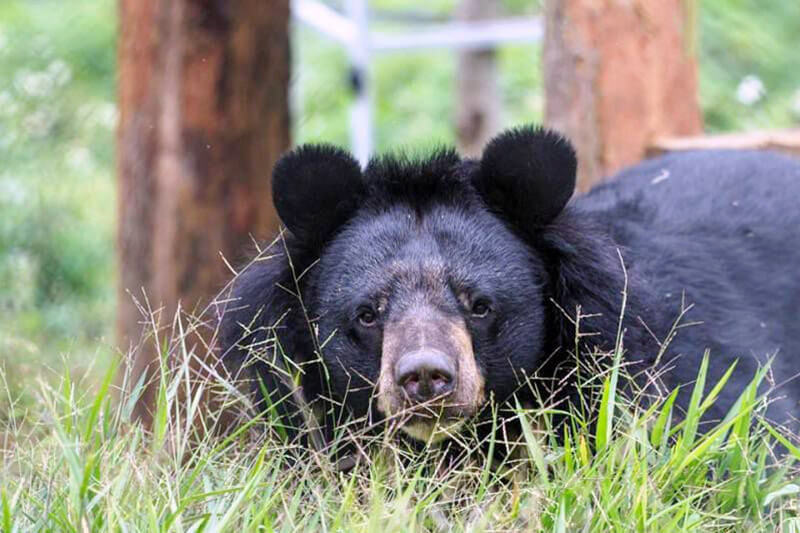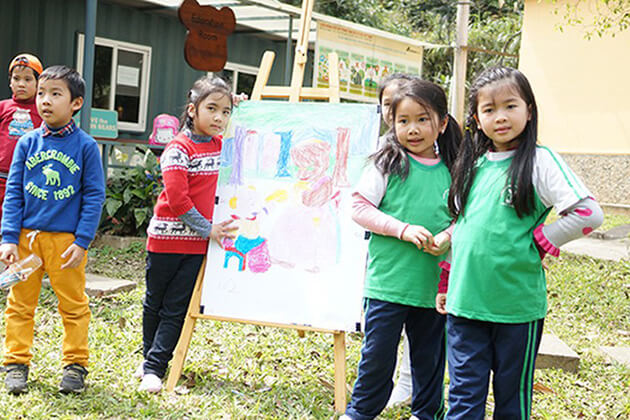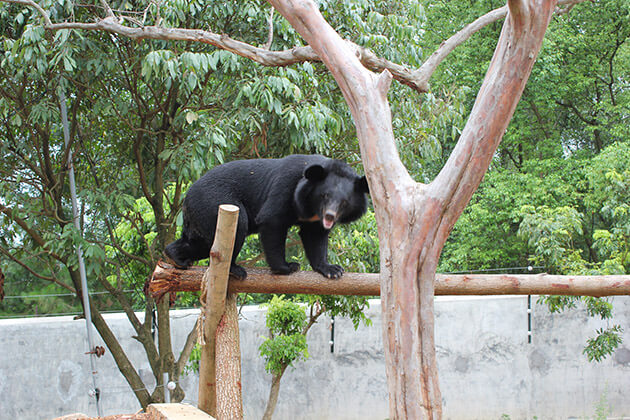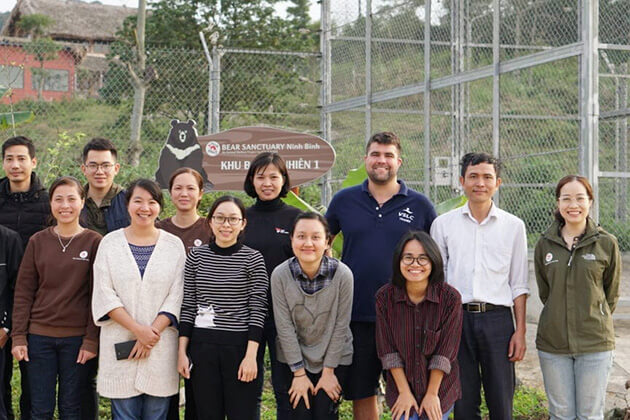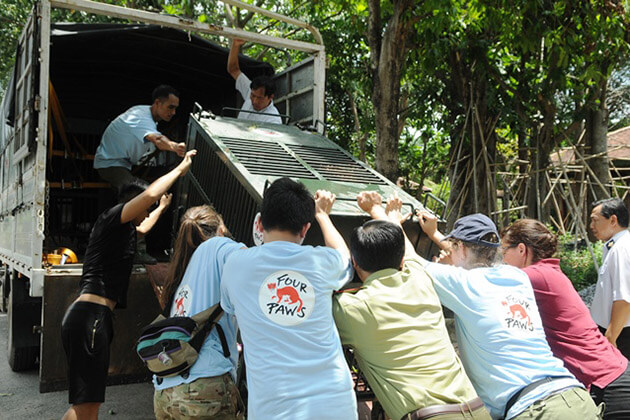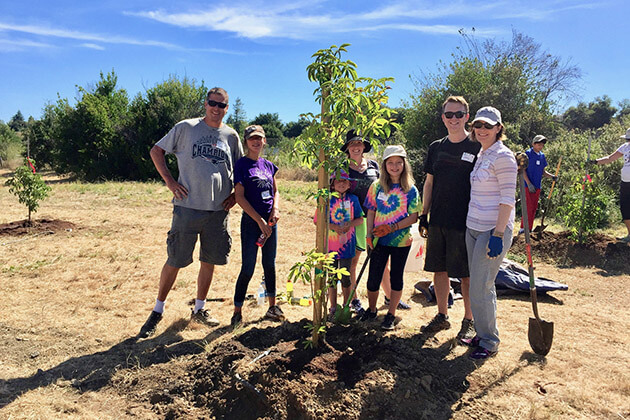Brief Information about The Bear Sanctuary
If you are looking for activities and environment relating to bears in Vietnam to organize school trips for teenagers and school students, welcome to the bear sanctuary in Ninh Binh. This base is being operated by an international wildlife welfare organization Four Paws was opened to the public in the northern province of Ninh Binh, marking a milestone for efforts to enforce laws on banning the abuse of bears for bile extraction farming. This can be done by providing a place for any confiscated or voluntarily handed over bears to be taken cared of appropriately. The sanctuary provides bears with 24-hour access to both the indoor and outdoor enclosures, including swimming in the wading pools, climbing on the high platforms specifically constructed for their needs, soak up the sun, play with other bears, forage for food or hide away in their dens when they want to relax. Traveling here you will have chances to join the staff in the journey of rescuing bears toward the aim of ending bear farming in Vietnam, understand nature, wildlife and find the way to live in harmony. The positive outcome of traveling and participating in volunteering exercises in the sanctuary will considerably be beneficial to school students.
Activities for Sightseeing
A lot of activities with free entrance fees are available for you. First, visitors can go to the Observation house to learn about the miserable life of bile bears in private farms and the terrible bear bile extraction process. Besides, you could discover the sanctuary design and the living condition of bears. There are videos explaining how bears were rescued and taken care of in the bear sanctuary in Ninh Binh. One of the most exciting things to do is go sightseeing the food prepared for bears in Bear Kitchen and Technical House; medicine and how to do the medication; the cool storage. Explaining a typical working day of bear keepers, the principle of pair working for the safety. Then, you can observe the bear waste treatment system, which is biological ponds and bear waste treated house.
Workshops Activities for Exploration
Drawing & Coloring Bear Pictures
The purpose of this activity is to boost the creative ability of children and to build their love with bears and with nature. Students are asked to share their authentic experience during their visit around the sanctuary. It is about what they have seen, which bears they love most, etc. Then, the children are allowed to draw their favorite bears based on their imagination and also the children can color based on their feeling. They can bring the completed products home or give it to the sanctuary for exhibition or selling to raise funds for the bears.
What Does a Bear Eat
In this activity, cards will be prepared with the name (or pictures) of bear food and the name (or pictures) of other food (not bear food). All cards will be mixed in a basket and put in the center of the room. Students are divided into groups of 5 students. There are 5 rounds and in each round, each team member will run to the basket to take the right bear food. Each round will be set a time of 5 seconds. After 5 rounds, the winning team will be the team with the most bear food cards/pictures. This helps children know about bear food.
 Mini Debate
Mini Debate
One of the most interesting activities to train critical thing for the students is the Mini debate. It offers students chances to analyze scenarios and emphasize their point of view using well-articulated defense.
Students are separated into teams of 3 to 4 people. Give each couple of pairs a topic about animals and toss a coin to see which team will be ‘for’ (agree) and ‘against’ (oppose) the topic. Each team will have 5 minutes to discuss and note down their points. Each team will have two minutes for their opening argument, followed by three 1-minute rounds to counter the opposing team’s claim. After the debate, the facilitator will tell them what worked well and what didn’t.
Nature Quiz
Nature quiz game aims to test the students’ knowledge and simultaneously get them interested in the biodiversity of Vietnam.
Activity: The facilitator will split the entire group into teams of 4 or 5 (depending on the class size) and conduct a multimedia-based quiz (videos, photos). For example, students will try to recognize animals by their patterns or colors or guess which animal lives in a certain habitat. After each round, the facilitator will also discuss the answers with the group.
 Listen to Nature
Listen to Nature
The theme of the activity is to use animal sounds from nature to spark the group’s imagination on the issues that face wildlife in Vietnam.
Activity: The facilitator will explain that this is a listening exercise and that students have to maintain complete silence to begin. Next, the facilitator will ask students to listen to sounds they can hear in the classroom and start listing out all the sounds they can identify. Then the facilitator will ask them to read out the different sounds they were able to identify from their classroom.
After this, the activity will be repeated, but this time the facilitator will play a series of sounds from nature, including sounds of animals and birds in their natural habitat. The sound clips will also include sounds of the destruction of forests, poaching and other wildlife crimes. The students might not be able to identify a lot of these sounds, because they haven’t been exposed to those sounds. The facilitator will use this as a medium to explain how we humans are becoming less sensitized about the natural world and hence find it difficult to relate to the problems we cause in nature. The facilitator can also start discussing some of the issues facing Vietnam in general. The facilitator could use pictures to give more visual cues about the topic.
Ecosystem Balance
When it comes to this game, students will evaluate how each link in the ecosystem can affect each other to create balance or imbalance.
Activity: The facilitator displays a chart of a simple food chain relationship in an ecosystem. The facilitator talks about how each link is important for each other. Then the facilitator asks a student to come and remove one link from the ecosystem chart. The group (either in teams or individually) tries to ascertain the impact of removing the link on the rest of the ecosystem. They can also create alternate scenarios where multiple links were removed and analyze what happens.
Discussion on Bear Bile as Traditional Chinese Medicine
The discussion could help to show the group how the business of exploiting animals in the name of medicine, is destroying the animals.
The activity format will be of a discussion that is aided by a presentation. The facilitator will talk about tigers, bears, seahorses, pangolins, and rhino, what their population’s current status is and why they are dying out quickly. The discussion will lead to the topic of ecosystem balance and animal cruelty – The facilitator could ask why humans should care about 5 animals or any other animal going extinct or about mistreating animals. This will reinforce the discussion on what will happen if these animals are removed from the ecosystem (empty forest syndrome). The facilitator should also cover how the students can do their part in ending these practices by talking about issues, supporting conservation issues and abstaining from wildlife products.
Boardgame
Another activity during the workshops is Board games, through which students can experience a journey of a community that tries to understand how to create a balance between the human needs/development and preserving the surrounding environment.
The facilitator sets up the room with each role and team’s station. Once the teams enter and take their places, the facilitator goes over the rules of the game once again (rules are discussed on the previous day as well). Next, the facilitator familiarises each station to the teams and demonstrates the timing for each round. If required a test round is played and all doubts are cleared before the start of the game. Depending on the time, the facilitator conducts 4 to 6 rounds of the game and tallies the scores.
Practical work
 Making Enrichment for Bears
Making Enrichment for Bears
In the 1st package, we will focus on enriching the provision of environmental stimuli to encourage the expression of bear's natural behaviors, allowing choice and increased control over their environment, preventing boredom and reducing stress. The staff here hope that food enrichment will allow the bears to express their natural behavior after years of being kept in the cage and eventually gain their natural instinct. The food is presented in different ways such as scattering and hiding it throughout their enclosures or using puzzle feeder toys.
The activity of making enrichment helps children understand how food enrichment works and helps the bears to recover their natural behaviors.
Cleaning the Sanctuary
You can support the new Ninh Binh Bear Sanctuary by assisting keepers in the cleaning of forest enclosures and bear dens. The activity sounds exciting to students. There is no need to worry about safety, the keeper staffs are well train and participants will be kept safe. Clearing bamboo or food preparation & distribution is an enjoyable task based on the judgment of many tourists coming here.
Tree Planting
Other tasks contributing to the effort of providing these bears the best environment are planting a tree, constructing climbing structures for them. It is widely known that climbing is the favorite hobby of bears, therefore the above seem never cease. Participating in this outdoor active activity and working with your friends will make your trip much more meaningful and memorable.

